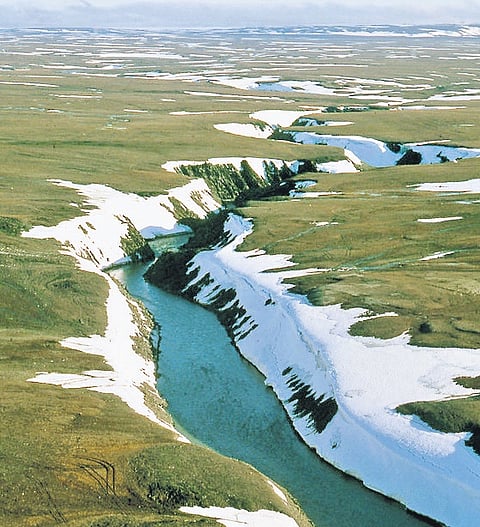

Climate change has long been linked to the rise of new health risks, particularly the spread of tropical diseases in temperate regions like Western Europe. However, recent scientific attention has shifted to another potential threat originating from the far north, where millennia-old microbes could be unleashed due to the rapid thawing of Arctic Siberian permafrost. Covering a staggering 25% of the Northern Hemisphere, permafrost serves as a frozen time capsule, preserving remnants of prehistoric life, including long-forgotten microbes.
Exploration into the microbial composition of Arctic permafrost began decades ago, with discoveries revealing the presence of bacteria in 1912. Yet, it wasn’t until the latter half of the 20th century that the significance of these microbial communities began to emerge, largely due to geopolitical tensions and language barriers. Permafrost, a term coined by American geologist and palaeontologist Siemon W Muller in 1943, refers to frozen soil layers found in high-altitude and high-latitude areas. These layers contain a rich mix of decomposing organic matter and diverse microorganisms, offering ideal conditions for preserving cellular structures and DNA. Hidden beneath layers of frozen soil, these microbes remain protected in an environment devoid of UV light, oxygen and extreme pH levels, which would obliterate such microorganisms. Below the active layer, where water is absent, metabolic activities cease, killing off most microbes.
However, some organisms can enter a dormant state known as cryptobiosis, allowing them to survive for extended periods. This phenomenon extends to viruses, which can remain viable in deep permafrost for thousands to millions of years. As permafrost thaws, ancient microorganisms, including prehistoric bacteria and viruses, are released and reactivated, some of which may still be infectious and resistant to modern antibiotics. Permafrost layers also contain mummified remains of woolly mammoths, reindeer, woolly rhinos, siberian wolves, and even humans, within which bacteria, viruses, and spores have been cryogenically preserved.
Dubbed “zombie viruses” by scientists, these ancient pathogens have the potential to wreak havoc once unleashed. Among the discoveries unearthed so far are a dozen viruses dating back tens of thousands of years. The oldest known virus, dating back 48,500 years, a giant virus called Pandoravirus yedoma, was found buried beneath a lake in Yukechi Alas, in the Russian Far East. Several other viruses have been extracted from various sources, including the fur of a mammoth and the intestines of a Siberian wolf. In laboratory experiments, these ancient viruses have demonstrated their ability to infect single-celled organisms like amoeba, raising concerns about their potential threat to human health.
Genetic treasure trove But the permafrost holds more than just ancient viruses. It also harbours genetic material from relatively recent epidemics. Lung samples from a woman buried in Alaskan permafrost in 1997 revealed traces of the deadly 1918 influenza strain, a virus that claimed millions of lives worldwide. Similarly, genetic remnants of the smallpox virus were discovered in 2012 in the mummified remains of a woman buried in Siberia 300 years ago, long after the disease was believed to be eradicated. Yet, perhaps the most alarming revelation came during the 2016 anthrax outbreak in Siberia, triggered by the rapid thawing of permafrost, allowing old spores of Bacillus anthracis, the causative agent of anthrax, to re-emerge from ancient human burial sites or animal carcasses infecting dozens of people and thousands of reindeer.
Epidemiologists provide assurance regarding the potential control of ancient bacterial epidemics by modern antibiotics, despite the discovery of antibiotic-resistant genes in permafrost. Antibiotics are a crucial tool in combating various bacterial diseases due to their broad-spectrum activity. They are expected to be effective against a range of bacterial pathogens, including those responsible for diseases such as plague, anthrax, legionellosis, typhoid, tuberculosis, and salmonellosis. However, the same level of efficacy does not extend to viruses. Viruses require highly specific antiviral medications or vaccines for effective treatment and prevention.
Recent pandemics have underscored the necessity of targeted approaches in combating viral infections, even when they belong to known virus families. The emergence of a virus previously unknown to medical science or our immune system, thus, poses a significant threat, highlighting the importance of preparedness and vigilance. To prevent the potential escape of biological threats from permafrost, halting the thawing process and addressing the underlying climate crisis are paramount. Proactive measures are essential in mitigating the risks associated with the awakening of millennia-old microorganisms.
This necessitates a comprehensive understanding of ancient pathogens and coordinated global efforts to contain emerging threats. The challenge extends beyond the mere discovery of these zombie viruses to how the society responds to this new reality, emphasising the urgency of collaborative action and adaptation strategies in the face of evolving environmental and health challenges.